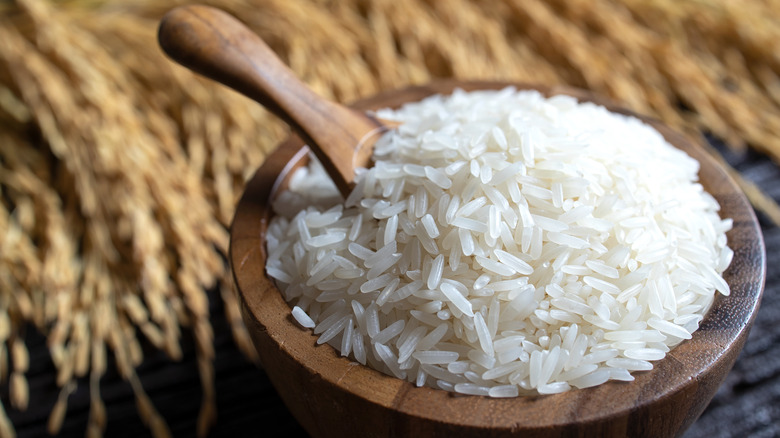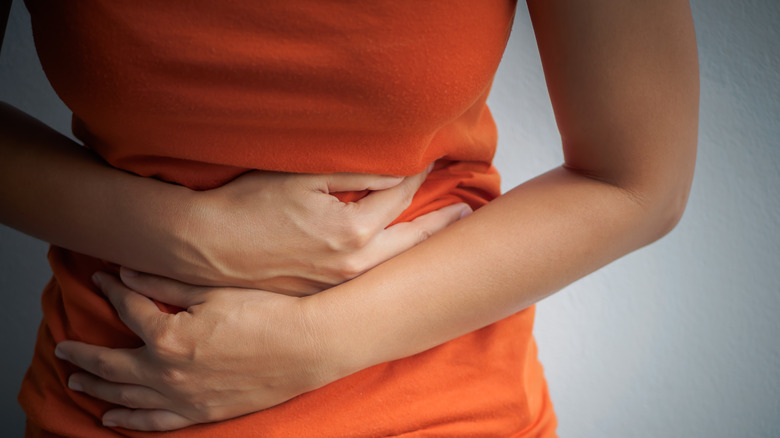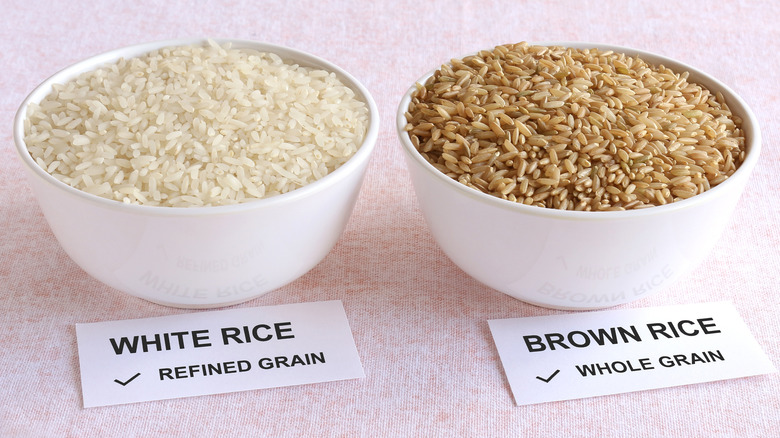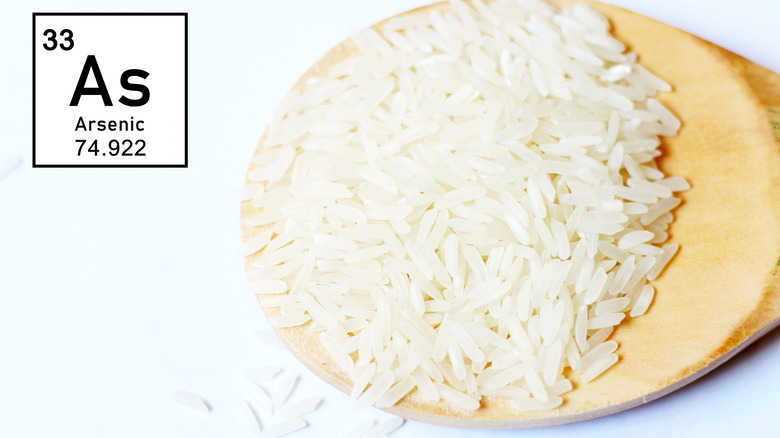When You Eat Too Much Rice, This Is What Happens To You
Feeling guilty about eating too much rice? While it's true that rice packs a lot of nutrients, it can potentially contribute to weight gain and digestive issues. Like with everything else, moderation is key. This grain is a dietary staple in more than 100 countries, notes the Harvard T.H. Chan School of Public Health. Rich in magnesium, selenium, phosphorus, manganese, and B vitamins, it can be a healthy addition to most diets. However, it's also high in carbs, which is something you should consider when planning your meals.
When it comes to cooked white rice, 1 cup has 44.6 grams of carbs and 4.25 grams of protein, according to the U.S. Department of Agriculture's Agricultural Research Service. The same amount of cooked brown rice has 45.8 grams of carbs and 4.52 grams of protein. The latter is also higher in magnesium, potassium, phosphorus than white rice. "The reality is that eating too much of any carbohydrate, including brown rice, can lead to diabetes," nutrition professor Clyde Wilson told Men's Health.
Brown rice is particularly good for you due to its high fiber content. Since it contains all three parts of the kernel, including the bran, germ, and endosperm, it's more nutritious than its refined counterpart, according to the University of Pittsburgh Medical Center. But what happens when you eat too much rice?
You may experience gas and bloating
While it's normal to feel full after a meal, you shouldn't look like you are carrying a food baby. Unfortunately, brown rice and other foods can create this effect. Board-certified physician Taz Bhatia says that brown rice may cause bloating, gas, belching, and digestive distress in some people (via MindBodyGreen). It can trigger inflammation due to its high carb content. Some individuals are sensitive to carbs and may experience digestive discomfort after eating whole grains.
Brown rice may cause digestive distress in people with small intestinal bacterial overgrowth (SIBO), according to Bhatia. As the name suggests, this condition is characterized by an overgrowth of bacteria in the small intestine. Its symptoms typically include nausea, bloating, diarrhea, poor appetite, and stomach pain, according to the Mayo Clinic. Bhatia suggests cutting out brown rice for about 6 weeks to see how your body reacts and then gradually reintroducing it back into your diet.
It's also possible to feel bloated just because you ate too much rice. Dietician Chloe McLeod recommends no more than a fist-sized portion. You may also want to avoid combining rice along with foods containing salicylates, amines, or fermentable sugars. These compounds occur naturally in garlic, onion, curry, baked beans, chickpeas, leeks, asparagus, and other foods (via Verywell Health).
You are at risk of developing diabetes
Rice has a glycemic index (GI) value of 48-93, according to the Harvard T.H. Chan of School of Public Health. This number indicates the impact of carbohydrate-containing foods on blood glucose levels. The higher the GI, the more your blood sugar levels will rise. White rice contains less fiber than brown rice. Therefore, it's more likely to affect blood sugar levels and increase diabetes risk. Brown rice, on the other hand, may protect against diabetes, notes Harvard T.H. Chan of School of Public Health.
Eating too much rice may also contribute to metabolic syndrome, a risk factor for diabetes. In a 2013 study, women who consumed white rice regularly were more likely to develop this condition than those eating rice with beans or whole grains. The white rice group also had higher rates of central obesity and hypercholesterolemia, or elevated cholesterol levels. These factors can further increase the risk of diabetes.
However, these studies took place over several years. An occasional bowl of white rice is unlikely to cause diabetes or weight gain — even if you go overboard. Just make you don't make a habit out of it.
Eating too much rice can lead to arsenic poisoning
Brown rice may be healthier than its refined counterpart, but you should still watch your portions. Both varieties contain a naturally occurring compound called arsenic, according to 2015 research featured in the Journal of Pediatric Gastroenterology and Nutrition. However, most of the arsenic in rice is found in the bran layers. White rice has its bran removed during processing, so it's lower in arsenic than whole rice.
Consumer Reports says that basmati rice from California is the lowest in arsenic. Quinoa, millet, and buckwheat may be safe choices, too. Brown rice and most rice varieties from Texas, by comparison, have high arsenic levels. Over time, this compound can accumulate in your body and contribute to heart disease, diabetes, and cancer. Despite these risks, there are no federal limits for arsenic in rice and other food products.
Whole rice, including organic varieties, may contain up to 80% more arsenic than its processed counterpart (via Consumer Reports). To stay on the safe side, rinse it thoroughly and cook it using 6 cups of water for each cup of rice. Drain the excess water and enjoy your meal. This cooking method may reduce the arsenic concentration by about one-third, according to Consumer Reports. Experts also recommend eating a variety of grains, especially bulgur, farro, buckwheat, and millet, to limit your exposure to arsenic.




